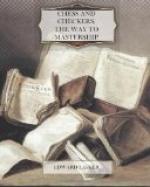Pieces that can be used for pinning a hostile man are, apart from the Rooks, the Queen and the Bishops; in fact pinning is the main activity of a Bishop throughout the game. Right after the first few moves one of the Bishops, as a rule, finds an opportunity to pin a hostile Knight. For instance: (1) P-e4, P-e5; (2) Kt-f3, Kt-c6; (3) B-b5 and as soon as the Pawn d7 moves in order to give an outlet to the Bishop c8, the Knight c6 is pinned. Or: (1) P-d4, P-d5; (2) Kt-f3, Kt-f6; (3) P-c4, P-e6; (4) B-g5 and the Knight f6 is pinned, as the Queen would be lost if the Knight moved.
+---------------------------------------+ 8 | #R | | | | | #R | #K | | |---------------------------------------| 7 | #P | #P | #P | #B | #Q | #P | #P | #P | |---------------------------------------| 6 | | #B | #Kt| | | #Kt| | | |---------------------------------------| 5 | | | | | #P | | ^B | | |---------------------------------------| 4 | | | | | | | | | |---------------------------------------| 3 | | ^B | ^Kt| ^P | | ^Kt| | ^P | |---------------------------------------| 2 | ^P | ^P | ^P | ^Q | | ^P | ^P | | |---------------------------------------| 1 | ^R | | | | ^R | | ^K | | +---------------------------------------+ a b c d e f g h
Diagram32.
The disadvantage arising from having a piece pinned is often that the opponent might be able to concentrate more men to attack the piece which is pinned than can be gathered for defense. The position of Diagram 32 will serve as an illustration.
Two of Black’s men are pinned, namely, the Knight f6 and the Pawn e5, and of both pins White can take advantage.
The Pawn e5 is attacked twice and defended twice. White cannot take Pawn, as he would lose Knight and Rook but would get for it only Knight and Pawn. However, he can win the Pawn by playing (1) P-d4. This attacks the Pawn for the third time and although Black can defend him for the third time with R-e8, the defense is not serviceable as Black would lose Pawn, Knight and Queen for Pawn, Knight and Rook.
P-e4 in answer to P-d4 would not help either; for on e4 the Pawn is twice attacked and only once protected as the Knight f6 cannot be counted as protection on account of his being pinned by the Bishop g5. All White needs to do is to take the Knight f6 first and then to capture the Pawn e4.
It remains to examine whether in answer to (1) P-d4 Black can take the Pawn with either Bishop or Knight. Apparently this is possible as the Pawn d4 is protected only by the Knight f3 and the Queen. Indeed, the combination would be correct if the Bishop d7 were sufficiently protected. As it is White wins a piece in the following way:
(1) P-d4 Bxd4 (2) Ktxd4 Ktxd4 (3) Qxd4 Pxd4 (4) Rxe7 Pxc3
Up to this move an even exchange of pieces has taken place, but now Black loses the Bishop which is attacked by White’s Rook, because White can remove the Knight which protects the Bishop.




